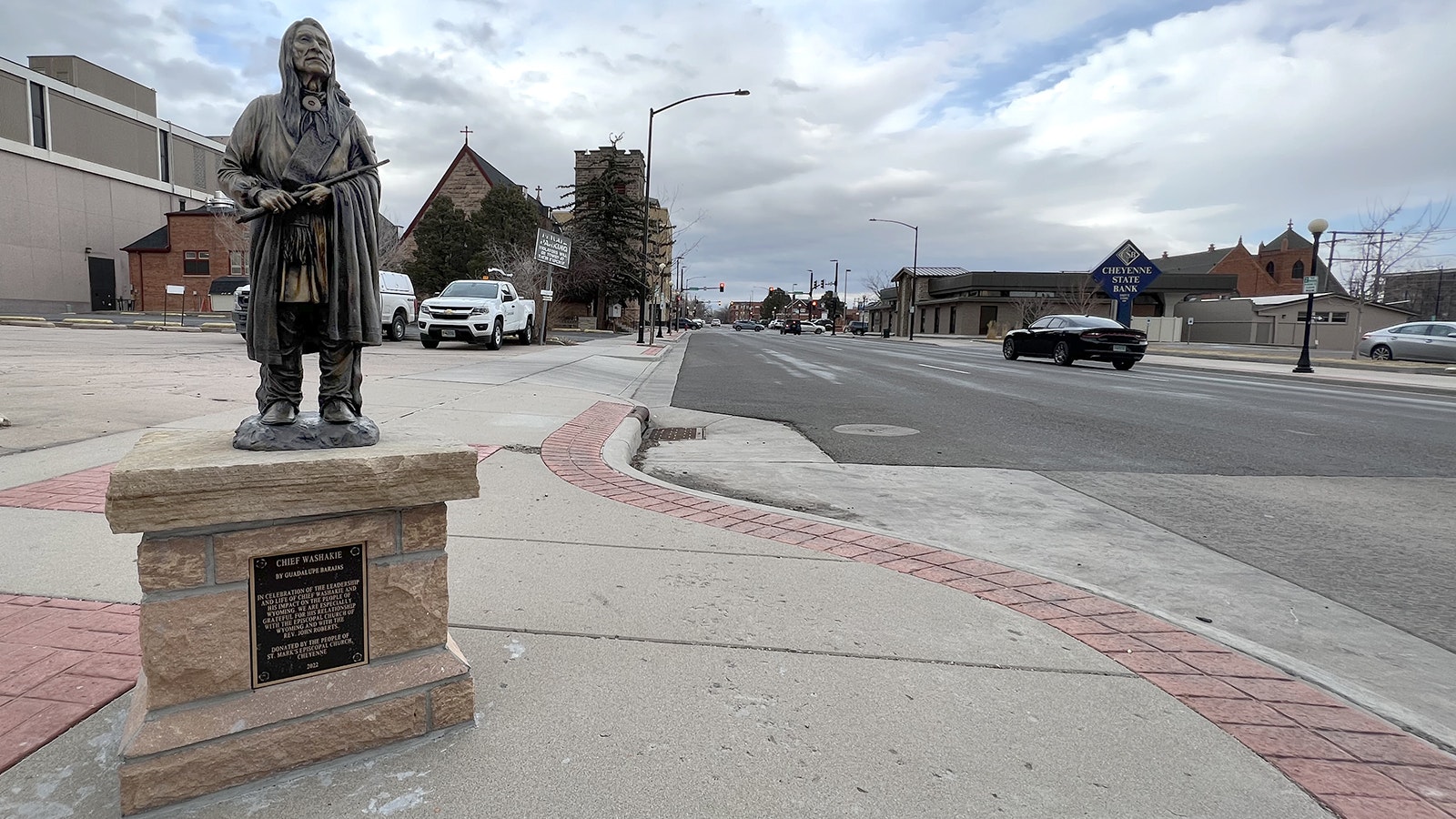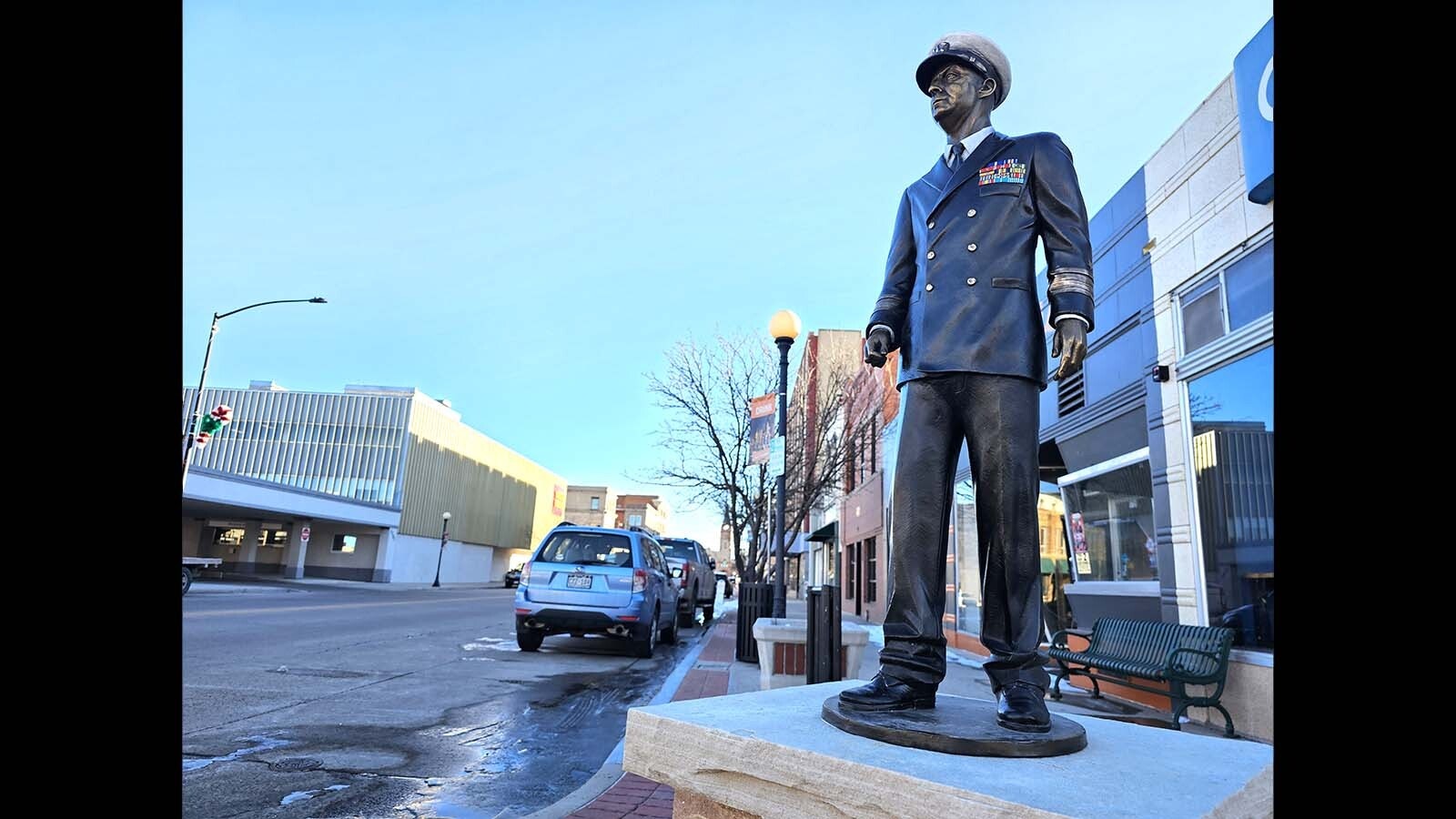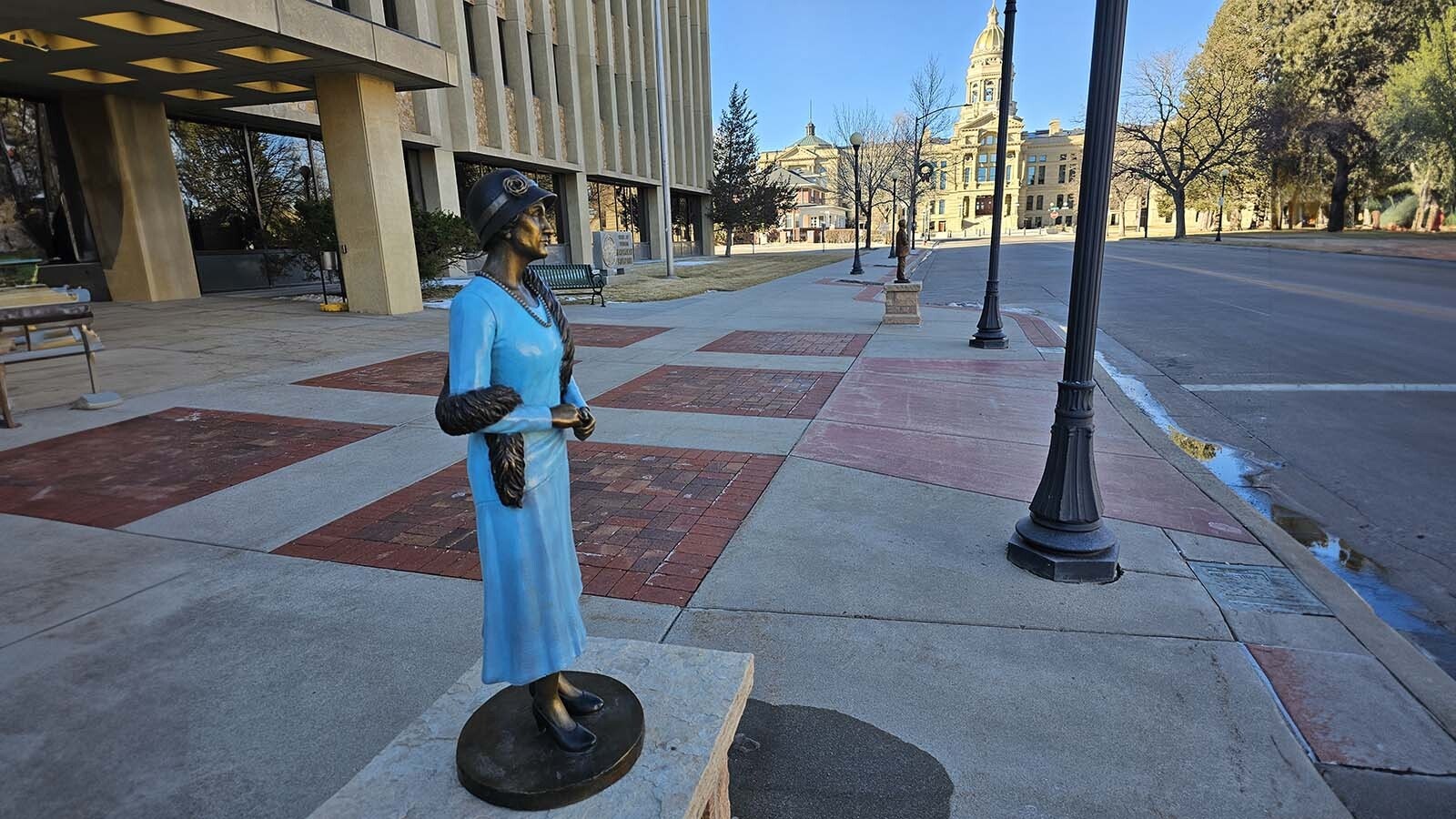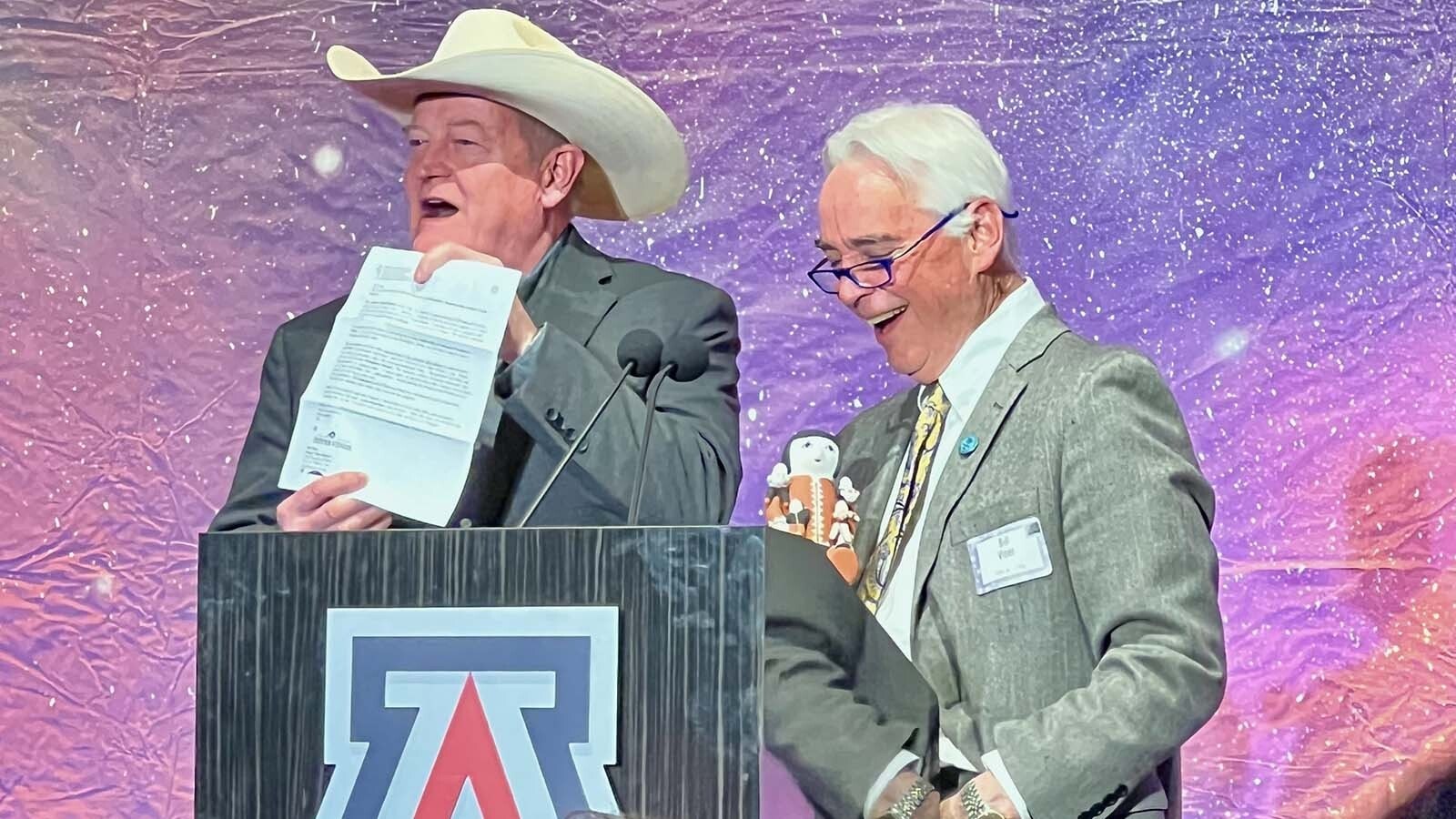CHEYENNE — Nathaniel Trelease’s first experience with bronze statues was as a young child in front of the Wyoming State Capitol.
To a small child, they were larger-than-life giants that couldn’t help but fire his imagination.
“My mother would always take us on walks to see the statues in front of the Capitol,” he said. “And I always thought that was incredibly inspiring.”
It’s the kind of inspiration Trelease hopes will fire up a new generation as Cheyenne’s Capitol Avenue Bronze Project closes in on its 100th sculpture. There have been 82 installed so far, and another nine are already spoken for and in the works.
That leaves just nine more to reach an even 100 statues for the project. The original goal was for just 32 statues.
Cheyenne art dealer Harvey Deselms had been dreaming of the Capitol Avenue Bronze Project since 2008, but it wasn’t until his dream met Trelease’s inspiration that it really took off.
Deselms had a dream one night in 2008 of bronze statues lining 17th Street, one for every corner, all illuminated and encased in fragile globes of glass.
“It was just bronzes everywhere,” Deselms said. “And I think I may have done a little bit of skipping along the avenue in the dream. I was just so happy that (all the artists) would have a permanent part of downtown.”
It was a beautiful dream, but that’s all it was until one day in 2021.
Trelease was in Deselms’ art studio talking about some framework Deselms had done for him. Along the way he mentioned his ambition to find a legacy project that would honor his mother.
Deselms, meanwhile, had already mentioned his dream of putting bronze statues up on 17th Street to Trelease before.
This time when Deselms mentioned it, Trelease’s eyes lit up.
‘A Project About Legacy’
The street he was seeing in his imagination wasn’t 17th Street, though.
It was the Capitol Avenue of his childhood.
“I loved seeing Esther Hobart Morris and Chief Washakie outside the Capitol, those monumental bronzes,” Trelease told Cowboy State Daily. “You look down the street toward the depot, which hadn’t been remodeled yet, but it was still there as a reminder of the history of the state.
“And in between the two was this great English Gothic cathedral that’s, what, 114 years old. That was always the most beautiful and inspiring set of blocks in Cheyenne.”
Imagine those same blocks with a bronze on every corner, Trelease thought.
They would tell a story that captured state history, and they couldn’t help but inspire new generations of children.
There couldn’t be a better tribute to his mother, who had similarly inspired his own childhood.
“This was always a project about legacy,” he said. “How do we remember the iconic figures in Wyoming’s history? The men, the women, the pioneers, the explorers, the Native Americans, the statesmen, the heroes and the artists, and make that a permanent part of our community?”
Closing In On 100
All 82 of the bronze statues inspired by Trelease and Deselms’ Capitol Avenue project have happened organically.
Deselms and the Capitol Avenue Bronze Project Committee don’t dictate to donors what the subject matter will be. They let families decide that.
The results, Deselms said, have been better than if they’d tried to force a certain vision onto the project.
The sculptures have captured not just the history of Cheyenne and Wyoming, but personality as well. Cowboy culture shines out from them, and it’s captivating to the tourists who visit each year.
Deselms said a week doesn’t go by that he doesn’t see someone from out of town taking a selfie with one of the statues or a small child hugging or kissing one of the animal sculptures.
Another point of pride, Deselms and Trelease say, is the fact there is no public money involved in the project at all. It is 100% privately funded.
Three Years To 32 Statues? Try 20 Months
Their goal in the beginning was much more modest than 100 statues, Deselms said.
“In 2021, we gave ourselves three years to get to 32 sculptures,” he said.
Mayor Patrick Collins, who met with the two men in October 2021, was excited about the project, but dubious that it would happen in the short time frame Deselms and Trelease envisioned.
There was good reason for the mayor’s skepticism. Deselms had already spent years raising $100 here and $100 there from 2010 to 2021. That had been successful in installing exactly three sculptures to that point.
At that rate, it would take many, many years to install a statue on every block of Capitol Avenue.
But sometimes, timing is everything. This timing happened to be right after the COVID-19 pandemic. Instead of taking three years to put up 32 bronzes, it only took 20 months.
“People didn’t know if that was a big nothing, or if that was something and most of us would be gone,” Deselms said. “I think we all know somebody who had it, probably know someone who died of it. That gave people time to think about if I’m going to leave a legacy, I probably should just not think about it but do it.”
Dixie Roberts, who was one of four who put up the first statues, agrees that has been a motivating factor for many.
“We all kind of looked at our mortality,” she said. “And people wanted to honor their families and their history and the legacy of the community.”
Because of that, Roberts said the committee hasn’t even had to go ask someone to put up a bronze.
“They come to Harvey and ask, ‘What can I do?’” Roberts said. “It’s never been work. It’s been just an act of love, I think, from all the donors who have participated.”
Hard To Choose Favorites
Roberts, like Trelease and Deselms, has many favorite statues among the 82 statues that now no longer just line Capitol Avenue, but have popped up in many other areas of town.
“It’s really hard to have just one favorite,” she said. “Because every time there’s a new one … they just seem to keep getting better and better.
“And then you go back and look at one that didn’t seem that important at the time, or wasn’t that significant and didn’t move you, and, as life experiences change, you look again and all of a sudden it means more.”
The stories behind the statues are also a factor in some of Roberts’ favorites.
“I’m always learning something I didn’t know anything about,” Roberts said. “Like the railroad one down on the corner by the Albany. The man who donated that, Jim Ehernberger, is a longtime railroad historian and worked for the railroad for many years.”
The sculpture is called “Comparing Time” and shows a railroad engineer and a railroad conductor comparing watches to synchronize their watches.
“What I learned from that one is that we have standard time because of the railroad,” Roberts said.
Prior to Nov. 18, 1883, there was only local, or “sun time,” which was based on the sun’s travel across the earth’s sky.
Sun time varied from one town to the next, and railroads couldn’t rely on that to schedule their trains. They had to synchronize.
“If it was 12:02 in Cheyenne, it might be 12:27 in Laramie,” Roberts said. “And so that’s why they all had their watches and were coordinating times. Because of that cumbersome process, that’s why we have standard time now.”
Some stories are more personal, like one of the sculptures that will be installed this week that shows a farmer named Bill Hutton standing with some hay bales.
The eagle-eyed will note that the “Haymaker” sculpture is missing a thumb.
“That’s a hazard of agriculture,” Deselms said. “Because, for example, my brother lost his arm in an agricultural accident. Bill lost his thumb. So, they said, ‘Be sure to sculpt him without that thumb.’ That’s part of the story of agriculture we can have there.”
Capturing Untold History
Some of the statues reveal little-known history that’s interesting and, even if only oral in nature, nonetheless sheds light on the personality of the state and its culture.
“The folks who funded the statue of F.E. Warren, their ancestor was Benjamin Franklin Ketchum,” Deselms said.
Ketchum was a Democrat, while Warren was a Republican.
“They got in a fist fight on the steps of the Capitol way back when, and that’s a story I had never heard,” Deselms said. “I don’t know if that is in any history books, but it’s such a cool story.”
A descendant of Ketchum, Beverly Black, and her husband Gordon decided to fund the statue to highlight not just F.E. Warren, but their family legends.
According to Beverly, her great-grandfather was giving a speech on the Capitol steps that Warren objected to, which led to the fistfight. Who won the fight that day has been lost to time. Though Warren would go on to serve as a U.S. senator as well as Wyoming governor.
Another oral history Deselms has heard involved Vern Elliott, who was in Buffalo Bill Cody’s Wild West Show in London.
“When they were there, it rained all the time,” Deselms said. “And it rained so much, they couldn’t sell any tickets, so they almost went bankrupt. They had to sell all the Native American costumes, the guns, the stock — everything — just to have enough money for everyone to travel back to these states.”
“The great stories we get to hear like that are a treat,” Deslems said. “Those kinds of stories aren’t really documented.”
Now those legends have been captured for all time in bronze for everyone to learn about.
Deselms believes it’s having a positive impact on tourism, as well as just the “vibe” of the downtown.
“I think a dozen or so people have told me that they’ve looked around at all the sculptures and decided to stay an extra night,” he said.
He’s also been told by former residents who return to visit Cheyenne that the city has a different vibe now, and they credit all of the artwork, from bronzes to murals and the giant boots at various businesses.
Once the Capitol Avenue Bronze Project gets to 100, Deselms has already decided what he’s going to do, and that’s to keep putting up more.
“We’ve got nine more to 100,” he said. “And 10 more to 101. And 101 is going to be just as exciting as 100, because it will start a whole new block of statues.”
Renée Jean can be reached at renee@cowboystatedaily.com.


























